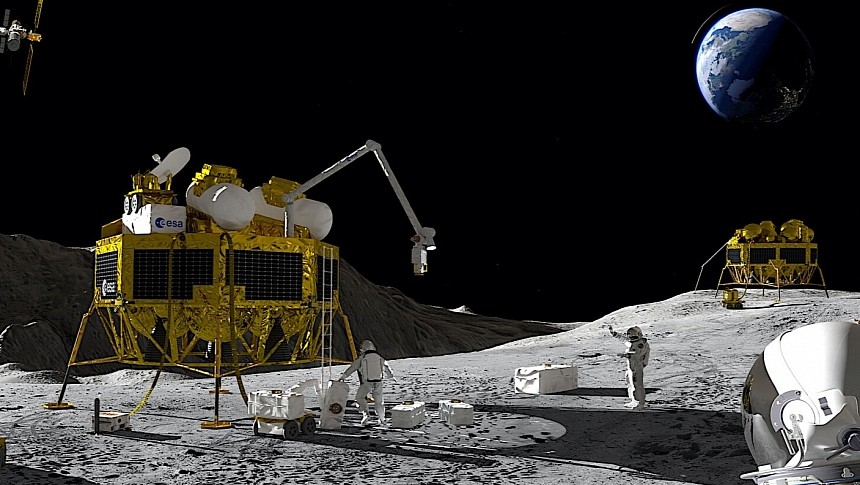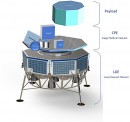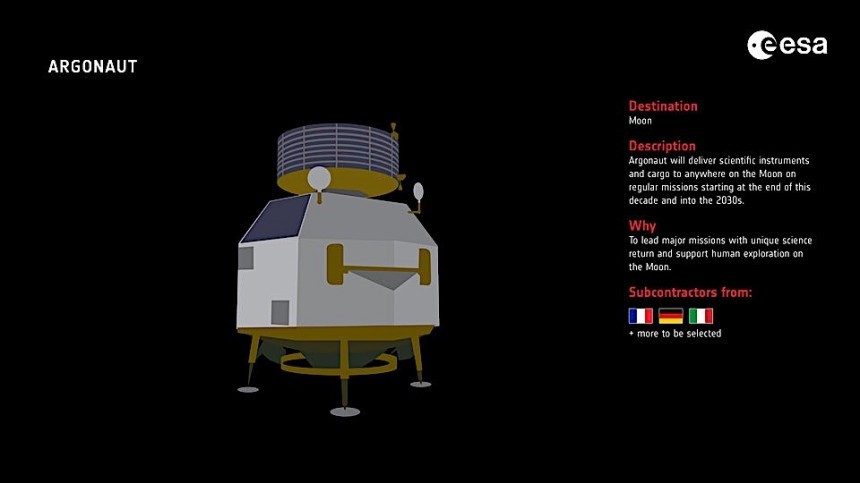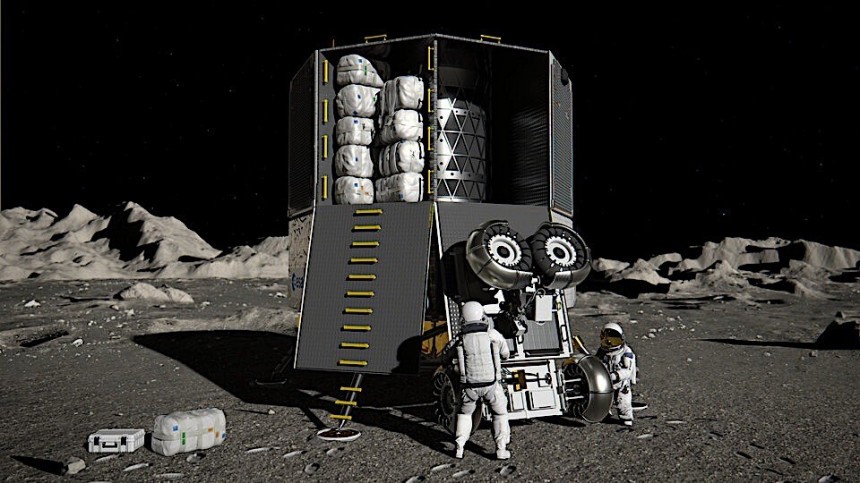On Friday, May 19, NASA announced who will be working on the Moon lander for the Artemis V crewed mission to the Moon - Blue Origin. It's an important piece of equipment for the future of space exploration, one that, together with the SpaceX Starship HLS of Artemis missions III and IV, should really open up the Moon for us.
But NASA's efforts of making Moon landers for the future are not the only ones. Space agencies from all over the world are doing the same, their dreams fueled by the successful first flight of the new American lunar exploration program.
One of the agencies to keep an eye out is ESA. Already involved knee-deep in Artemis, the European Space Agency is planning its own missions to the Moon, and all the dedicated pieces of hardware needed for that. Including landers, some not meant for humans, but cargo.
ESA's missions are not envisioned as stand-alone steps towards the colonization of the Moon, but support activities meant to advance the goal of existing programs. That means delivering supplies (anything from food to pieces of hardware, like rovers) to astronauts and installations that will soon make their way up there. Meaning everything needed for these missions to succeed in their goals.
That is why ESA's lander, named Argonaut, is fully autonomous, needing just a rocket to send it on its way, and a stretch of lunar real estate to land on. It could become, if you will, an important logistics component for Artemis, and it will of course be capable of backing independent science missions to our planet's natural satellite as well.
In essence, there will be little this lander won't be capable of carrying to the Moon. Launching atop an Ariane 6 rocket, it can carry with it to the Moon some 2,100 kg of cargo (4,630 pounds). For reference, that's the weight of your average car. The thing is not all that small, measuring 4.5 meters (14.7 feet) in diameter and six meters (19.7 feet) tall. When empty, it weighs here on Earth 10,000 kg (22,000 pounds).
Said cargo can be comprised of literally anything, from supplies needed for the survival of lunar astronauts (food, water, air) to various pieces of equipment, including rovers and other large machines, and even power stations, lunar telescopes, or production facilities for in-situ resource utilization (ISRU).
Once at its destination, the Argonaut will be able to land virtually anywhere on the Moon where its presence is required. It is up to the lunar descent element of the Argonaut to fly to the Moon and land on target, with an accuracy of between 50 and 100 meters (164 to 328 feet) of its designated area.
That's possible thanks to the fact the Argonaut will be connected to the ESA Moonlight constellation of communication and navigation satellites, planned for deployment in the coming years.
We're talking about a collection of hardware that would really put the Moon on the world map, sort of speak, by making stuff like fast streaming of video and audio, and even direct Earth-to-Moon phone calls "using your roaming data allowance," a reality for the people there. Separately, the volume of data sent back and forth would increase dramatically compared with what's possible now.
Once on the ground, the contents of the lander can be unloaded and transported to where they are needed. But once there, its role would not end, as if need be it could be converted into a sort of survival kit to be used by "the explorers of our new frontier" – exactly how that would work was not entirely explained.
The European Space Agency says a mission of the Argonaut would vary greatly, depending on its profile - the duration, for instance, could vary from anywhere between a week to a full month.
The name of the lander is said to continue the tradition of previous and ongoing Moon exploration programs, being inspired by Greek mythology. There, argonauts were the sailors of the Argo ship that set out to look for the golden fleece.
But ESA will take all of that one step further and announced plans for each of the missions to be named after each of the sailors in the myth – and there were 50 of them, the most famous being Jason, the leader of the bunch.
The Argonaut lander is still in its early stages, having just been approved back in 2022. Plans are though to have it ready in time to complete at least five missions over the next decade. An exact date as to when we can expect it was not provided, but the first landing should occur before 2030.
ESA has been for a long time a solid partner for NASA's space exploration efforts, but it's kind of refreshing to see it does plan its own hardware for what may come ahead. In fact, there's an entire European space exploration vision being developed. It's called Terrae Novae, and we'll talk about it in an extensive coverage next week.
One of the agencies to keep an eye out is ESA. Already involved knee-deep in Artemis, the European Space Agency is planning its own missions to the Moon, and all the dedicated pieces of hardware needed for that. Including landers, some not meant for humans, but cargo.
ESA's missions are not envisioned as stand-alone steps towards the colonization of the Moon, but support activities meant to advance the goal of existing programs. That means delivering supplies (anything from food to pieces of hardware, like rovers) to astronauts and installations that will soon make their way up there. Meaning everything needed for these missions to succeed in their goals.
That is why ESA's lander, named Argonaut, is fully autonomous, needing just a rocket to send it on its way, and a stretch of lunar real estate to land on. It could become, if you will, an important logistics component for Artemis, and it will of course be capable of backing independent science missions to our planet's natural satellite as well.
In essence, there will be little this lander won't be capable of carrying to the Moon. Launching atop an Ariane 6 rocket, it can carry with it to the Moon some 2,100 kg of cargo (4,630 pounds). For reference, that's the weight of your average car. The thing is not all that small, measuring 4.5 meters (14.7 feet) in diameter and six meters (19.7 feet) tall. When empty, it weighs here on Earth 10,000 kg (22,000 pounds).
Once at its destination, the Argonaut will be able to land virtually anywhere on the Moon where its presence is required. It is up to the lunar descent element of the Argonaut to fly to the Moon and land on target, with an accuracy of between 50 and 100 meters (164 to 328 feet) of its designated area.
That's possible thanks to the fact the Argonaut will be connected to the ESA Moonlight constellation of communication and navigation satellites, planned for deployment in the coming years.
We're talking about a collection of hardware that would really put the Moon on the world map, sort of speak, by making stuff like fast streaming of video and audio, and even direct Earth-to-Moon phone calls "using your roaming data allowance," a reality for the people there. Separately, the volume of data sent back and forth would increase dramatically compared with what's possible now.
Once on the ground, the contents of the lander can be unloaded and transported to where they are needed. But once there, its role would not end, as if need be it could be converted into a sort of survival kit to be used by "the explorers of our new frontier" – exactly how that would work was not entirely explained.
The name of the lander is said to continue the tradition of previous and ongoing Moon exploration programs, being inspired by Greek mythology. There, argonauts were the sailors of the Argo ship that set out to look for the golden fleece.
But ESA will take all of that one step further and announced plans for each of the missions to be named after each of the sailors in the myth – and there were 50 of them, the most famous being Jason, the leader of the bunch.
The Argonaut lander is still in its early stages, having just been approved back in 2022. Plans are though to have it ready in time to complete at least five missions over the next decade. An exact date as to when we can expect it was not provided, but the first landing should occur before 2030.
ESA has been for a long time a solid partner for NASA's space exploration efforts, but it's kind of refreshing to see it does plan its own hardware for what may come ahead. In fact, there's an entire European space exploration vision being developed. It's called Terrae Novae, and we'll talk about it in an extensive coverage next week.








